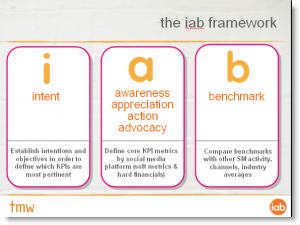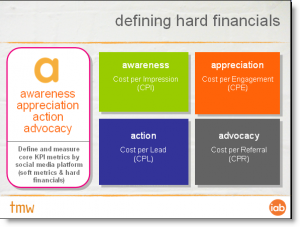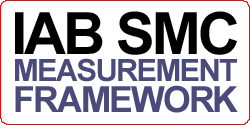By , Communications Executive, IAB
The debate about social media measurement has been running for as long as we in the IAB Social Media Council can remember (which either means that it’s a significant industry issue OR our excessive dependency on social networks has destroyed our long-term memories, I’d go for the former).
The on-going discussions are based on a number of key questions. Can social media activity be evaluated in the same way as other, more traditional techniques? If yes, which aspects should be measured? What measurement tools are available? Is it expensive? How time consuming is it? Once I have these results, what do they even mean? Difficult questions to answer, and perhaps a lesser group might flee at the prospect of attempting to bring some meaning to the measurement debate, but not the IAB.
The IAB social media council measurement sub group have launched their first initiative of 2011 – a guide to social media measurement and intent which addresses some of the hottest topics within the area and providing further insight on the IAB measurement framework, why it was created and how it works. The guide has been put together by council representatives from TMW, COI, Outside Line; We Are Social, NMIncite and Market Sentinel.
The document really emphasises the importance of objectives in social media, and how concrete intents are essential to bring about meaningful measurement. Inside, we offer an explanation on the differences between earned, owned and bought social media activity, the importance of social media monitoring and why you need to take the time to get to know your audience and your competitors. The guide also breaks down different types of social media focusing on the one size DOESN’T fit all ethos and that different brand/campaign objectives can mean there is a need for a different social media strategy approach to fit within these aims. It also offers a dedicated section on what’s happening within customer services and social networking? offering suggested objectives, benchmarks and metrics to consider before embarking on customer service activity.
The guide has been written for both advertisers and agencies, and like any IAB Social Media Council initiative, we hope it evolves over time, so greatly value your feedback.
By Amy Kean, IAB,
Thank heavens for the research release today, from YouTube, which confirms a sneaking suspicion that I – and the IAB Social Media Council – have had for a while. If a brand enters social media… they should tell the world why they’re there in the first place.
That’s obvious, you might say. Simple common sense, some may tweet. Absolutely – I don’t think anyone actually ever claimed that social media was a form of rocket science – but it still doesn’t happen that often. And that’s because there exists an assumption that hasn’t yet been disproved (until today) that just entering into a conversation is enough, that a ‘like’ or retweet is unequivocally fabulous, and that blogger coverage, without a rationale for why you’ve received it, is sufficient.
This research from YouTube (supported by the IAB) highlights the real need for harder messaging in social media content and advertising, showing that a really quite remarkable 60% of people are not yet existing customers of brands they share or ‘like’. They just like them. Now I’m no Rain Man, but that’s a big number. Read more…

Back in July the IAB released it’s Social Media Measurement framework. This framework sparked a number of conversations about different approaches to measurement and best the ways to implement such a framework.
The framework itself has been a great resource for marketers to lay-down measurement foundations; however, overtime, depending on your campaigns, there may well be a need to use more advanced metrics for more specific and granular evaluation of campaigns.
Market Sentinel have been working on number of research and measurement metrics to help the more advanced marketeers or community managers. Some recent work includes:
- The assesment of response metrics
- Understanding the context of product demand through social meda
- Determining the sociability of topics
- Planning Research Metrics
pic via janGlas
, senior PR and marketing manager and head of social media council, IAB
This week we launched the IAB framework for social media measurement. Hopefully you’ve seen some of the coverage and the full presentation with all the details, but I thought I’d take some time just to give you a bit more background about why we came up with it, and what we hope having such a framework will achieve.
Why the IAB framework?
First and foremost the strength of the framework lies in its simplicity and memorability – a deliberate tactic to encourage wider adoption within the industry. Of course a lot of experienced practitioners have robust methodologies already in place to measure social, and we fully recognise that these are making a lot of clients very happy the world over! Our aim has never been to suggest the industry is measuring it in the wrong way, but rather in an inconsistent way across the board, which makes it difficult to compare or for the industry to grow as a whole. Read more…
One of the biggest ‘hot potatoes’ right now is how to measure social media activity and whether it’s possible to apportion ROI. It seems every man, woman and dog has an opinion on the matter!
And for good reason.
The days of whimsical experimentation have long gone. Nowadays, marketers have to justify every budget line with robust KPIs, solid business cases or definitive break-even/ ROI analysis. Not so easy when it comes to evaluating that ‘fluffy social media stuff’ but if we genuinely want this to be taken seriously it’s imperative we start making it much more accountable.
More accountability, more standardisation
But for this to happen there really needs to be a degree of standardisation across the industry so that we’re all talking the same language (or at least singing from the same ‘karaoke machine’!) But the truth is there’s currently too much inconsistency in the industry to draw any salient or meaningful conclusions. As it stands, it’s almost impossible to benchmark our respective activity as everyone is measuring performance differently. This is compounded by the fact that social media is so versatile, diverse, complex and multi-faceted, spanning many disparate objectives and many different platforms - no wonder we’ve struggled to find a common methodology which works across everything.
A step in the right direction
What I’m about to share with you may not address all these challenges but will hopefully move us in the right direction. TMW have been working in close consultation with the IAB Social Media Council to develop a new measurement framework to help practitioners evaluate their social media activity more effectively and consistently. It’s not rocket science. In fact, it’s a very simple framework, designed to be flexible enough to be applied across a broad spectrum of social media platforms, whilst at the same time giving practitioners the freedom to use their own experience and expertise to choose the most appropriate KPIs.
Rather serendipitously, the measurement framework we’re proposing shares the same acronym as the Internet Advertising Bureau, so at least it’s dead easy to remember!

You can view the full presentation of this approach below.
The presentation talks through each step of the process from establishing up front your intent, assigning the most pertinent KPIs according to the 4 As – Awareness, Apprecitation, Action and Advocacy – and consulting other benchmarks in order to draw meaningful comparisons.
There’s an array of KPIs which one can assign to each of these 4 As. As a starter for ten we’ve provided a selection to choose from but this list is not exhaustive by any means. Which KPIs you choose to apply will fundamentally vary according to the intent you define, the platform you’re using, the tracking you have in place and the internal expectations of various stakeholders and whether they demand hard financials as well as soft metrics.
Defining some hard financials
Ultimately, I believe we all need to be working towards some hard financials which over time will become established as industry standards. I’ve deliberately steered away from ROI per se – that’s a debate for another day – but instead would favour the four financial KPIs in line with the 4 As (see table below). How we calculate these KPIs is still to be defined but the principle of having one or more of this hard financials to evaluate or benchmark our activity could be extremely beneficial in my view.

Feedback welcome
The Council plans to officially promote this framework to the wider industry in a couple of weeks, but it would be great to get some feedback to ensure this is a collaborative effort. What we’ve outlined may not suit everybody but we believe it’s a step in the right direction and would encourage as many practitioners as possible to adopt it where they can. The more aligned the industry becomes, the more accountable social media will become and the easier it will be for all of us to digest the complexities of social media measurement.
Surely that’s something worth striving for?
By , head of digital strategy, Imagination
Browsing through research and social spaces as I like to do I came across this fascinating graph on TechCrunch last week.

It’s fascinating not because it shows a drop off in Facebook from December 2009 although that’s probably worth a column in itself, but because it shows the popularity of Stumbleupon. Stumbleupon has been helping users find random, rated content since 2001. It’s not new and it’s not flashy but it is very definitely a social space.
Users love stumbleupon for 3 reasons – peer-recommendation, simplicity and serendipity. Essentially they get great stuff from people they like in their network.
I’m not suggesting that Stumbleupon should be at the heart of every social media strategy, social media strategies should not be based purely on numbers but on relevance. Still, it reminded me again about the importance of considering your audience and being sure you know where they hang out online.
What this graph clearly illustrates is that the usual suspects are just that, usual. And it can pay to truly consider the whole social market place when you are investigating social media strategies. Or you might miss the most important place to be because it’s not the most high profile.
The IAB’s resident Paxman, , interviewed , commercial director at Unruly Media about what makes a successful viral campaign to dispel the myths that surround the area. Steve talks about what results clients are looking for from their campaigns using the Evian case study as a positive benchmark for brands, and what’s makes good creative.
Watch the below video to see the full interview…
by (vice SMC chair), Head of Buzz Metrics, nielsen
When something you don’t like reminds you of something you don’t like…
You know one thing I really don’t like? Sugar cubes. They really frustrate me. I mean, for something that is supposed to be so sweet and tasty, they are so annoying. Sugar cubes take forever to dissolve, and to speed up the process, I just keep stirring and stirring, making my drink cold. In addition, their form factor is supposed to be superior, but I don’t get it. I still have to use a spoon to take one and put it in my drink, just like granulated sugar. Also, there is no way to have a half a cube of sugar in my drink like there is with the other stuff. What is this post actually about, you ask? Well, I was at a meeting this week – stirring away – when I heard yet another major company talk about how they were ‘doing social media’ as they were ‘doing Facebook and Twitter.’ When I asked them why they were using these platforms, silence filled the room and puzzled expressions came across their faces.
You see, here is how many very well known companies seem to get involved in Social Media:
- First, an executive sees a presentation at an event, reads an article, or has a meeting with a consultant who talked about the Armageddon that is social media and the end of advertising models as we know them.
- This triggers a basic corporate reaction – the message flows downhill. This executive then turns to PR, Marketing, Brand, Research, etc. and tells them to put ‘Social Media’ on their list of objectives in 2010 and to go out and ‘do social media’.
- The final stage of this process includes the selected department determining that social media is Facebook and Twitter and therefore they launch a presence on these platforms.
Thus, when I ask them why they are doing this – i.e. what are their goals or objectives in using these platforms – they draw a blank. Social Media is a huge topic with so many activities, platforms, technologies, and aspects that it can overwhelm the most sophisticated and experienced business leader. The topic is so broad and vast, that trying to label or define it can become comical (just ask the IAB UK Social Media Council).
Rather than measure ‘social media,’ I believe companies should place much more emphasis on listening and using social media for strategy creation rather than jump right into execution or engagement. Listening and learning from this then can inform decisions to focus on destinations like Facebook and Twitter. Alternatively, companies and brands should look to define their objectives first, then determine if social media is a viable way to meet these objectives. For example, a brand may want to increase awareness, advocacy, retention, or churn, or decrease negative discussion and identify threats. A brand may want to begin to measure and treat each mention like an impression, something they are more familiar with measuring. Each of these components is much easier to breakdown into its individual parts and measure accurately and effectively. Otherwise, in my mind, social media measurement becomes as useful as a sugar cube.
Fleur MD of Pass it On Media was interviewed by IAB’s senior PR and marketing manager, on social media influencers. This 10 minute video covers how to spot a worthwhile influencer, how influencers help campaigns and how they can be detrimental in a PR crisis. Fleur talks through the processes at Pass it On on how to recognize a worthwhile influencer, what tools they use for this and how important it is to keep an influencer fully involved with the campaign and be honest and transparent throughout the whole process in order to gain the best results.
At the end of the video Fleur also mentions her involvement with the IAB social media measurement sub group and how they are currently working towards setting actual usable metrics for the industry.
By Dhiren Shingadia, Mindshare UK
I had a conversation with a fellow industry insider last week about the tools market and the number of tools that are set to reach us soon.
One in particular is Looking Glass by Microsoft: a marvel of information design. Looking Glass seems to have reignited rumours about a rival Google offering and free tools for all.
Whilst all of this is great, I cannot help but backtrack to a few years ago when Google gave everybody free onsite Analytics. Adoption rates were high, but effective utilisation of the tool and its data is still low.
With everyone taking a greater interest in buzz monitoring and social media metrics, are marketers exposing themselves to yet another layer of information that doesn’t get fully utilised?
The need for analysts is now key in every agency and marketing team. Data from buzz monitoring tools, onsite analytics, CRM and business intelligence needs to be analysed holistically so key actions and outputs can be derived. Our tool sets, free or paid for, will continue to grow and as this occurs our expertise in making the most out of them needs to grow simultaneously.






